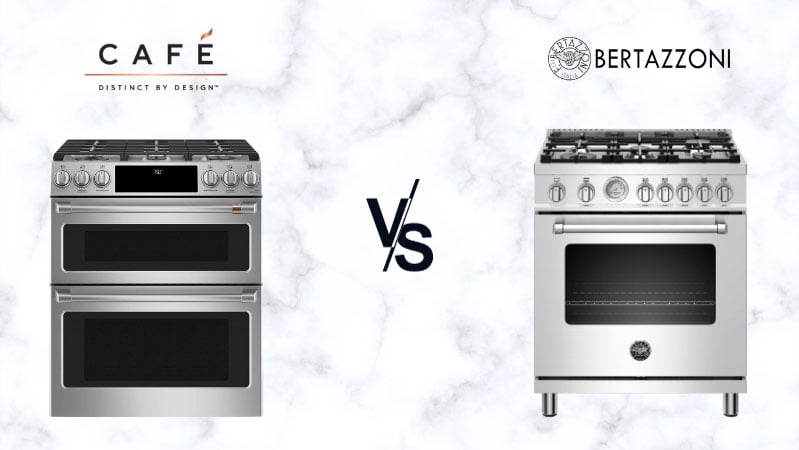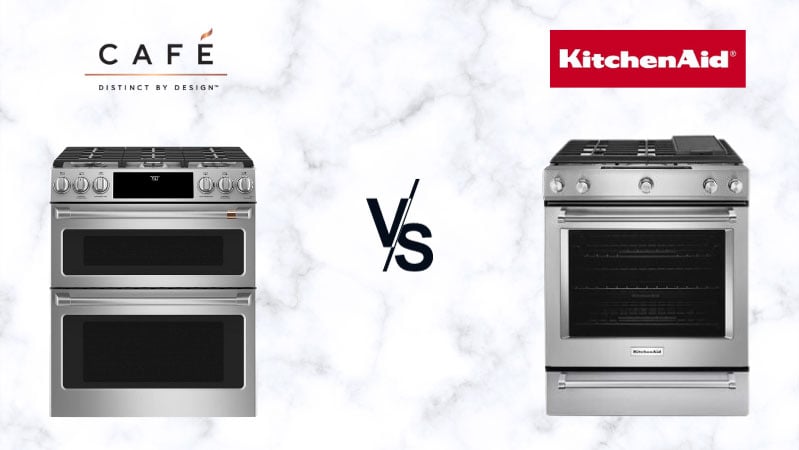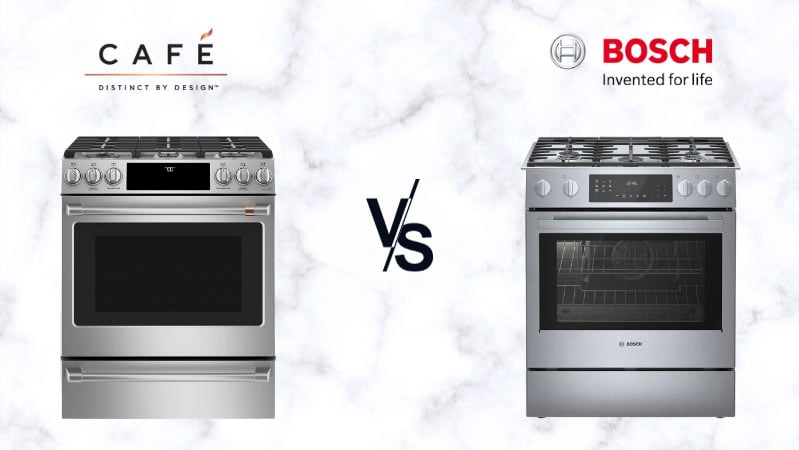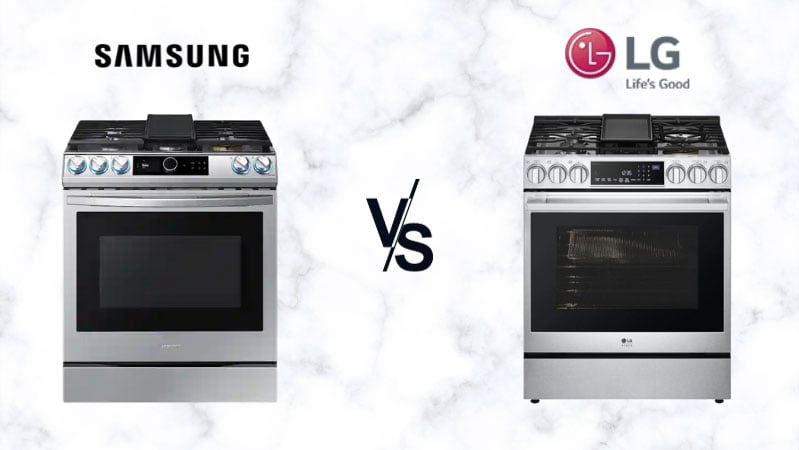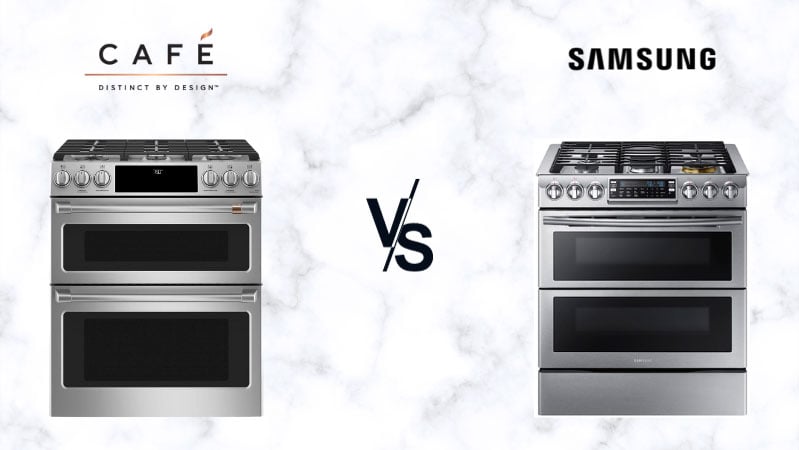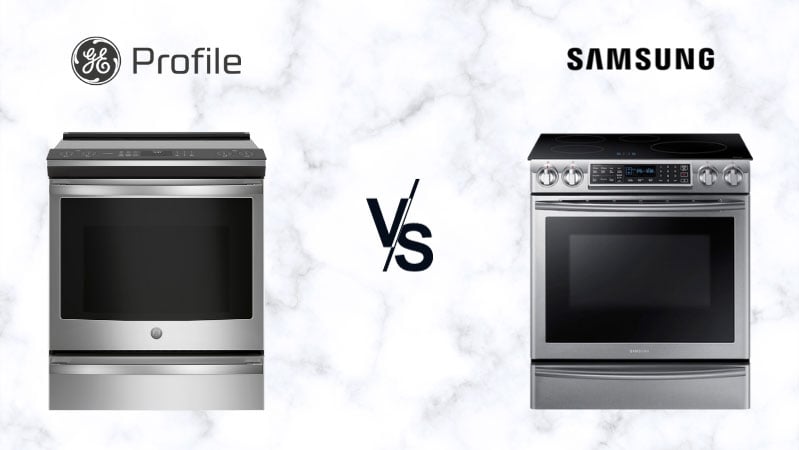How to Buy a Kitchen Range: The Ultimate Guide
Whether you're looking for an upgrade, replacing an old unit, or just tired of uneven cooking and heat distribution, you're in the right place to learn how to choose a new kitchen range.
Start finding answers to your kitchen range questions
Are you daunted by the plethora of kitchen range options, from outdated, inefficient models to the latest induction, gas, and electric freestanding technology? Perhaps you're seeking a more state-of-the-art cooking experience and reliable information to guide your purchase.
Choosing the ideal kitchen range, with the numerous fuel types, styles, and features available, can seem overwhelming. Understanding your cooking needs and preferences is essential before diving into the market.
That's where "How to Buy a Kitchen Range" steps in. We empathize with the complexities of the decision-making process and are dedicated to being your trusted guide, offering unbiased and insightful information. While many appliance reviews might appear rosy, hands-on user feedback frequently provides a broader perspective.
Our approach is grounded in real-world expertise. Last year, our service team addressed over 33,000 service calls, providing a deep understanding of recurring challenges and the reliability metrics of various kitchen ranges.
We believe in transparency and unfiltered honesty. Our main goal is to arm you with ALL the indispensable details, ensuring you're well-informed and confident in your choice.
Bypass the confusion of mixed reviews and kitchen disappointments.
In this comprehensive guide, we'll navigate the vital aspects to bear in mind, presenting you with recommendations for the top kitchen ranges in 2023. Whether you have your heart set on an induction range, a gas slide-in range, or an electric range, we're here to light the path.
With "How to Buy a Kitchen Range" by your side, you'll be equipped to select a kitchen range that seamlessly aligns with your culinary desires and elevates your cooking endeavors.
Let's embark on this enlightening journey to discover the best range tailored for your home.

Steve Sheinkopf
Steve Sheinkopf is the third-generation CEO of Yale Appliance and a lifelong Bostonian. He has over 38 years of experience in the appliance industry, and he is a trusted source of information for consumers on how to buy and repair appliances.
Steve has also been featured in numerous publications, including the New York Times, Consumer Reports, The Boston Globe, Bloomberg Radio, the New York Post, The Wall Street Journal, and Entrepreneur, for his knowledge of how to buy appliances and appliance repair.
Steve is passionate about helping consumers find the best appliances for their needs, and he is always happy to answer questions and provide advice. He is a valuable resource for consumers who are looking for information on appliance buying, repair, and maintenance.
Despite being the worst goalie in history, Steve is a fan of the Bruins and college hockey, loves to read, and is a Peloton biker. The love of his life is his daughter, Sophie.
Buying a new kitchen range seems overwhelming, but it doesn't have to be.
Learn how to separate the marketing fluff from what really matters so you can choose the right cooking appliance. Over 700,000 people have already found answers in a Yale Appliance guide.
Table of Contents
The Best Kitchen Ranges
Browse the best available options and read reviews of our top picks
Best Kitchen Ranges for 2023
To kick off your range-buying journey, let's take a look at some of the best ranges available in 2023. These top picks have been carefully selected based on their performance, features, and customer satisfaction. Whether you're a passionate cook or a casual home chef, these ranges will elevate your culinary experience.
Best Induction Ranges
Induction ranges are known for their precise and efficient cooking. With rapid heating and responsive controls, induction ranges offer a seamless cooking experience. Induction cooking is a method that utilizes electromagnetic fields to heat the cookware directly, resulting in faster cooking times and precise temperature control. In this article, we'll explore the best induction ranges on the market, ensuring you find the perfect fit for your kitchen.
Here are some top picks:
Best Overall: Miele HR 1622-3 I CTS
Miele offers the best all-around range with a powerful cooktop, twin convection oven, M Touch controls, smart functionality, and a wireless probe for precise temperature control.
Highest Output: LG LSIS6338F
LG provides the highest output range with a 4,300-watt burner, large 6.3 cubic feet oven, and reliable performance. It also offers smart functionality for convenient control.
Best Double Oven: Café Appliances CHS950P4MW2
Café Appliances features a double oven with the largest capacity of seven cubic feet, a decent output, Wi-Fi enabled smart functionality, and various stylish design options.
Most Reliable: Bosch Benchmark HIIP057U
Bosch offers a reliable induction range with a sleek design, excellent output, a warming drawer for convenience, and high reliability ratings. The oven size is 4.6 cubic feet.
Most Available: Beko PRIR34452SS
Beko provides a Pro-Style induction range with decent burner output, a larger-than-average 5.7 cubic feet oven, self-cleaning mode, and competitive pricing. It is widely available for purchase.
Most Popular: GE Profile PHS930YPFS
GE Profile is a popular choice for a single oven induction range, offering impressive burners, a 5.3 cubic feet oven, smart functionality through the SmartHQ app, and access to a wide range of recipes.
Least Expensive: Samsung NE63B8211SS
Samsung offers an affordable option with a 6.3 cubic feet oven, although the burner output is relatively low. However, it lacks some advanced features found in higher-end models.
These models provide a range of options based on features, performance, reliability, and price, allowing you to choose the induction range that best suits your needs. Whether you prioritize power, oven capacity, smart functionality, or affordability, there's an induction range on this list to cater to your preferences.
To learn more about the best induction slide-in ranges, read our articles: The Best 30-Inch Induction Ranges and The Best 36-Inch Induction Ranges.
Best Gas Slide-In Ranges
Gas ranges have long been a popular choice for cooking enthusiasts. With their instant heat control and even heat distribution, gas slide-in ranges offer a versatile and reliable cooking experience. In this guide, we'll explore the top gas slide-in ranges for 2023, featuring powerful burners, spacious ovens, and impressive features to elevate your culinary endeavors. Whether you're seeking exceptional performance, reliability, affordability, or stylish design, we have curated a list of the best gas slide-in ranges to suit your needs. Let's dive in and discover the perfect gas range for your kitchen.
Best Service Network: GE Profile PGS930YPFS
A powerful gas slide-in range with a 21,000 BTU burner, convection oven, and a reliable service network.
Most Reliable: LG Studio LSGS6338F
A highly reliable gas slide-in range with hot burners, pure convection oven, and a large 6.3 cubic feet capacity.
Most Affordable: Beko SLGR30530SS
An affordable gas slide-in range with a 5.7 cubic feet oven, warming drawer, and decent burner output.
Best Double Oven: Café Appliances CGS750P2MS1
The best double oven gas slide-in range with seven cubic feet capacity, separate ovens, and a powerful 19,000 BTU griddle burner.
Best Value: Bosch HGI8056UC
A stylish gas slide-in range with two high-powered burners, a 4.8 cubic feet oven with convection, and a warming drawer. Get up to $1,000 with their kitchen package rebate program.
Largest Oven Capacity: Samsung NX60T8711SS
A stylish gas slide-in range with a powerful 22,000 BTU burner, a 6.0 cubic feet oven, and a focus on design (note: limited service availability).
These gas slide-in ranges offer various features, capacities, and styles to cater to different cooking needs and preferences.
For a comprehensive overview of the best gas ranges, read this article: The Best Gas Slide-In Ranges.
Looking for answers about ranges?
Schedule a showroom visit that works on your schedule. We offer flexible scheduling of showroom visits, phone calls, and video calls.
The Most Reliable Kitchen Ranges
Learn what makes a kitchen range reliable and the best brands to avoid costly repairs
The Most Reliable Kitchen Ranges for 2023
Reliability is a crucial factor to consider when investing in a range. You want a range that will serve you well for years to come, with minimal maintenance issues. In this section, we'll focus on the most reliable ranges in each fuel type category, including induction, gas, and electric ranges. By choosing a reliable range, you can have peace of mind knowing that your investment will stand the test of time.
Induction Range Reliability
When it comes to induction ranges, reliability is a crucial factor to consider. Induction ranges offer advantages such as faster cooking times, better simmering capabilities, easier cleaning, and enhanced child safety. To determine the most reliable induction range brands, a study based on nearly 40,000 service calls from the previous year was conducted. The data was collected from real users, making it a reliable source for evaluating appliance performance. The study compared the number of products sold to the number of units serviced over a 12-month period. The following brands emerged as the most reliable:
- Bosch (5.4% Service Rate): With a service rate of 5.4%, Bosch induction ranges are renowned for their exceptional quality, sleek design, and affordability. Although Bosch offers a limited selection of induction ranges, their reliability and customer service make them a popular choice for homeowners.
- Café Appliances (9.3% Service Rate): Despite a service rate of 9.3%, Café Appliances' induction ranges are considered more reliable and feature-rich compared to the less expensive GE Profile range. The Café Appliances double oven induction range stands out as one of the best options available, providing ample cooking space, precise temperature control, and a self-cleaning function.
- LG (9.9% Service Rate): Known for their reliability in various home appliances, LG maintains a service rate of 9.9% for induction ranges. LG appliances excel in performance and energy efficiency, thanks to their innovative and durable motors. LG's commitment to environmentally conscious design makes them a trusted choice for consumers.
These brands have proven themselves reliable in terms of performance and service, making them solid options for those seeking a dependable induction range for their kitchen.
If you're interested in more information about the most reliable induction ranges, you can read this article: The Most Reliable Induction Ranges.
Gas Range Reliability
Gas ranges are known for their reliability, with an average service rate of 8.5%, lower than the average for all appliances. However, adding more features to a gas range can increase the need for service. Nevertheless, several brands have proven to be reliable options. Based on service rates calculated from the number of gas ranges sold and serviced from January 1, 2022, to December 31, 2022, the most reliable gas range brands for 2023 are:
- LG (4.1% Service Rate): LG Electronics takes the top spot for gas ranges, boasting a service rate of only 4.1%. Despite not ranking as highly for induction ranges, LG's commitment to manufacturing various components contributes to the reliability of their gas ranges.
- Café Appliances (8.9% Service Rate): Café Appliances impresses with their innovative designs and features, maintaining a service rate of less than 9% even with options like double ovens and griddle burners. They strike a balance between functionality and dependability.
- GE Profile (9.8%): GE Profile offers a perfect balance of reliability, performance, and features. With precise temperature control, spacious ovens with convection capabilities, and elegant designs, GE Profile gas ranges are backed by excellent customer service.
These brands provide reliable gas ranges with various features, ensuring a high-quality cooking experience for homeowners.
To read more about the most reliable gas ranges and gain further insights into their performance and service rates, click this link: The Most Reliable Gas Ranges.
Electric Range Reliability
When it comes to electric ranges, reliability becomes a crucial consideration. Electric ranges are generally more reliable due to their refined and standardized technology. The glass tops of most electric ranges are still made by SCHOTT, a manufacturer that has maintained its quality over the years. However, service rates can vary depending on the brand and the number of features offered.
Based on the calculation of appliances serviced compared to appliances sold, the following brands have proven to be the most reliable:
- LG (2.3% Service Rate): With a service rate of 2.3%, LG electric ranges have demonstrated excellent reliability. LG appliances are known for their quality and innovative features, making them a trusted choice for consumers.
- GE Profile (2.4% Service Rate): With a service rate of 2.4%, GE Profile electric ranges offer reliability and performance. They are designed with advanced features and sleek aesthetics, ensuring a seamless cooking experience.
- Whirlpool (3.3% Service Rate): Whirlpool electric ranges have a service rate of 3.3%. Whirlpool is a reputable brand known for its durable and dependable appliances. Their electric ranges combine functionality with modern design, making them a reliable choice for many households.
- Beko: Beko electric ranges have a service rate of 6.2%. While slightly higher than the other brands listed, Beko still maintains a respectable level of reliability. Beko offers a range of features and options to suit different cooking needs.
These brands have shown to be reliable choices for electric ranges, minimizing the need for repairs and providing long-lasting performance. It is advisable to research and read reviews of top-rated appliance service providers in your area to ensure prompt and efficient repairs, as the industry often faces delays in service and parts availability. Additionally, being cautious with self-cleaning cycles in older ranges is recommended to prevent potential issues.
To learn more about the most reliable electric ranges, you can check out this related article: The Most Reliable Electric Ranges.
Fuel Type
When selecting a range, the fuel type is an important decision. Learn the differences between induction, electric, and gas cooking
Fuel Type
Selecting the fuel type for your kitchen range is an important decision that extends beyond mere preference. Today's kitchen range choices can have far-reaching consequences on health, cooking efficiency, and the environment.
The fuel type you choose—be it gas, electric, or induction—not only affects your day-to-day cooking experience but also aligns with broader energy trends and safety considerations.
With evolving technology and shifting regulations, understanding the differences between these options has never been more crucial. Here’s what you need to consider:
Advantages of Gas Ranges
- Immediate Heat Control: Gas ranges offer precise temperature control that is instantly responsive.
- Cooking Versatility: They accommodate a wide array of cooking techniques with accessories like grills and griddles.
- Power Outage Resilience: Gas burners can be lit manually when the power is out.
Advantages of Electric Ranges
- Even Cooking: Electric ranges provide even heat distribution, ideal for baking and roasting.
- Lower Initial Cost: They are typically less expensive to purchase and install compared to induction ranges.
- No Special Cookware Needed: Electric ranges work with all types of cookware.
Advantages of Induction Ranges
- Speed and Efficiency: Induction ranges heat up quickly and cook food faster than both gas and electric ranges.
- Safety and Cleanliness: With a cool-to-the-touch cooktop and smooth surface, induction ranges are safe and easy to clean.
- Energy Efficiency: Induction cooking uses less energy and heats only the cookware, not the entire cooking surface.
Comparing Gas, Electric, and Induction Ranges
Heat Control
Gas ranges excel in heat control, electric ranges offer even cooking, and induction ranges provide the fastest and most precise temperature changes.
Cookware Compatibility
Gas and electric ranges work with all cookware, while induction requires magnetic pots and pans.
Installation
Gas ranges need a gas line, electric ranges require a standard electrical outlet, and induction ranges often necessitate electrical upgrades.
Cost
Gas ranges have a higher operating cost than electric and induction, which are more energy-efficient.
For further information and a more detailed comparison, you can also check out this article: Induction vs. Gas Cooking
The Shift from Gas to Induction
Despite the benefits of gas ranges, a shift towards induction cooking is evident, driven by:
Health Concerns
Gas ranges emit harmful fumes like nitrogen dioxide, which can affect indoor air quality and respiratory health.
Environmental Regulations
Some states are banning gas ranges in new buildings due to their environmental impact.
The Challenges of Switching
Transitioning from gas to induction involves overcoming obstacles such as:
Electrical Upgrades
Moving to induction can require significant rewiring and upgrades to electrical circuits, with costs that can exceed $3,000.
Cookware Investment
Induction ranges necessitate magnetic cookware, leading to potential additional expenses.
Availability of Qualified Technicians
Finding electricians for the necessary installations can be challenging due to labor shortages.
For further information on why people are making the switch, you can also check out this article: The Challenges of Shifting from Gas Stoves to Induction Cooking.
Transitioning from Gas to Induction: A Step-by-Step Guide
- Evaluate Your Electrical Requirements: Determine if your current kitchen setup can accommodate the higher electrical demands of an induction range.
- Upgrade Your Electrical System: If necessary, hire a qualified electrician to upgrade your wiring to a 240-volt, 40 or 50-amp circuit.
- Selecting Induction-Compatible Cookware: Ensure your cookware is induction-ready, which may involve purchasing new pots and pans with magnetic properties.
- Choose the Right Induction Range: Consider the size, features, and price point that fit your kitchen and cooking needs.
- Professional Installation: Have a professional install your induction range to ensure safety and compliance with local building codes.
- Disposing of Your Old Gas Range: Follow local regulations and recycling programs for the disposal of your old appliance.
For further information on how to effectively manage the switch from gas to induction cooking, you can also check out these article: 6 Steps to Convert Your Gas Range to Induction
In conclusion, while gas and electric ranges have their own set of advantages, the trend towards induction cooking reflects a growing emphasis on health, safety, and environmental sustainability. Choosing the right range will depend on weighing these factors against personal preferences and kitchen requirements.
Freestanding vs. Slide-In Ranges
Understand the key differences so you can learn which is best for you and your kitchen
Freestanding vs. Slide-In Ranges
When it comes to choosing between freestanding and slide-in ranges, there are several key differences to consider. In this section, we'll explore these distinctions to help you make an informed decision for your kitchen:
Installation: Freestanding ranges can be placed anywhere in your kitchen, while slide-in ranges sit seamlessly between cabinets. Front control ranges are a hybrid between freestanding and slide-in, offering flexibility in placement.
Control Location: Freestanding ranges have burner and oven controls located on the backguard, whereas slide-in ranges feature upfront controls for easier access. Front control ranges have controls on the front panel, similar to slide-ins.
Cleanability: Slide-in ranges offer a cleaner look by eliminating the seam between the range and countertop, making it easier to clean spilled food particles. Freestanding ranges have a backguard that can be more challenging to clean.
Price: Freestanding ranges are generally more affordable, with prices starting at around $499-599, while slide-in ranges typically start at $1,000 or more. Additionally, freestanding ranges may offer a wider selection of options compared to slide-ins.
Appearance: Slide-in ranges provide a built-in look and allow for showcasing your backsplash since there's no backguard blocking the view. This can enhance the overall aesthetics of your kitchen.
Replacement Considerations: Front control ranges can directly replace existing freestanding ranges without the need for modifications to counters or cabinets. However, slide-in ranges require precise measurements and potential adjustments to fit properly.
Ultimately, the choice between freestanding, slide-in, or front control ranges depends on factors such as budget, installation requirements, preferred style, and the importance of cleanability. Considering these differences will help you select the range that best suits your needs and complements your kitchen design.
For more information and visual references, you can refer to the full article: What’s the Difference Between Freestanding and Slide-In Ranges?
Brand Comparisons
Once you know the basics, start comparing popular brands to narrow down your options
Compare Popular Range Brands
To assist you further in your range-buying journey, we've compiled a series of comparisons between popular range brands and models. By examining the strengths and weaknesses of each option, you can narrow down your choices and find the perfect range for your needs. From Café vs. Samsung double oven gas slide-in ranges to KitchenAid vs. Café Appliances gas slide-in ranges, we'll provide you with valuable insights to make an educated decision.
How to Buy a Kitchen Range
Follow this plan to choose the best range for your home or project
Start With a Plan
Choosing the right range involves considering multiple factors beyond cooking performance. This section will guide you through the essential steps to follow when buying a range, whether it's a gas, induction, or electric range. We'll cover key considerations such as size, styles, best features, premium options, reliability, budget, and timing. By understanding how to evaluate these aspects, you'll be well-equipped to select a range that aligns with your requirements and preferences.
Size & Style: Size is an important factor to ensure that the range fits well in your kitchen space, regardless of the fuel type. Range styles vary, including freestanding, slide-in, and professional-style options, each with its own advantages regardless of whether it's gas, induction, or electric.
Features: Exploring the best features for ranges is crucial, such as convection ovens, high-powered burners, and self-cleaning functions, which are available across different types.
For those seeking a premium experience, ranges offer additional features like Wi-Fi connectivity, touch-screen controls, and advanced cooking modes, regardless of the fuel type.
Reliability: Reliability is another crucial factor, and it's advisable to research brands known for producing durable and long-lasting ranges, regardless of whether they are gas, induction, or electric.
Budget: Determining your budget is essential, as ranges can range from affordable options to high-end models with premium features, regardless of the fuel type.
Best Time to Buy: Finally, knowing the best time to buy a range can help you find better deals and discounts, such as during holiday sales or promotions, regardless of whether you're looking for a gas, induction, or electric range.
To explore these criteria in more detail and understand how to buy a range effectively, you can refer to the following articles: How to Buy a Gas Range and How to Buy an Induction Range.
Looking for answers about ranges?
Learn how to separate the marketing fluff from what really matters so you can choose the right cooking appliance. Over 700,000 people have already found answers in a Yale Appliance guide.
Kitchen Range Buying Mistakes
Avoid Common Mistakes When Choosing a Cooking Range
Don't Make These Mistakes
When buying a cooking range, informed decisions are essential to ensure you get the most value for your money and a range that suits your needs. Here are the key mistakes to sidestep when choosing between electric, gas, and induction ranges, accompanied by tips to guide your selection:
Misunderstanding Range Styles: Distinguishing between freestanding, front control, and slide-in ranges is vital. Be cautious not to replace an old freestanding range with a slide-in range without anticipating necessary modifications.
- Tip: For new constructions, slide-ins are a great choice due to their seamless fit. If replacing a freestanding range, consider front control ranges.
Confusing Electric and Induction: Just because electric and induction ranges look similar doesn't mean they function the same. Induction uses magnetic heat, offering rapid heating, while electric ranges use coils to heat the glass.
- Tip: If quick heating and child safety are priorities, opt for induction, but ensure you have the required 50-amp power supply.
Neglecting Gas Range Ventilation: Gas ranges can introduce harmful gases if not adequately ventilated.
- Tip: Ensure proper ventilation when using a gas range to maintain a safe kitchen environment.
Not Balancing Dual Fuel Benefits: A dual-fuel range combines a gas cooktop and electric oven. While the electric oven is great for baking due to its precision, a gas oven provides moist heat ideal for broiling or roasting.
- Tip: Reflect on your cooking habits. If you frequently bake, lean towards electric ovens; for roasting or broiling, consider gas.
Ignoring Power Requirements for Induction: Induction ranges need more power than typical gas or electric ranges.
- Tip: Check your home's power capacity if considering induction, especially in condos or apartments.
Overlooking Range Capacity and Configuration: The size and layout of the range should cater to your cooking habits and kitchen space.
- Tip: Consider the number of burners, oven space, and additional features like griddles or grills.
Prioritizing Price Over Functionality: While budget is crucial, focusing solely on price may mean compromising on features, performance, or durability.
- Tip: Strike a balance between cost and essential features to ensure longevity and satisfaction.
Neglecting Reliability and After-sales Service: Brand reliability and post-purchase service are crucial for long-term satisfaction.
- Tip: Look into customer reviews, ratings, and warranty offerings of the range you're considering.
Forgetting to Measure: Always measure the space in your kitchen dedicated to the range to ensure a proper fit.
- Tip: Account for height, width, and depth to avoid any installation headaches.
By sidestepping these pitfalls, you're better equipped to make a sound cooking range purchase.
Service & Maintenance
Learn common issues and preventative maintenance to protect your purchase
Troubleshooting Common Range Issues
Like any appliance, ranges may require maintenance or encounter common problems over time. In this section, we'll focus on some of the most common issues that can occur with gas ranges and induction ranges, and provide insights into troubleshooting them.
For gas ranges, one common problem is when the igniter won't light. This can be caused by a faulty igniter or a blocked burner port. We'll provide you with troubleshooting tips to address this issue. Another common problem is when the igniter constantly clicks even after the burner has lit. This could indicate a faulty spark module or a dirty igniter, and we'll guide you on how to resolve this.
In some cases, you may find that the ceramic base of a gas range is broken. This can happen due to thermal shock or accidental impact. We'll discuss the potential solutions for this issue. Additionally, burner color changes can occur over time, which may indicate a problem with the air-to-fuel ratio. We'll explain what to look for and how to address it. Erratic sparking of the igniter is another issue that can be caused by moisture or dirt buildup, and we'll provide tips on troubleshooting and resolving this problem.
When it comes to induction ranges, it's important to consider the electrical requirements. Induction ranges typically use 40-50 amps, whereas electric ranges typically use 30 or 40 amps. It's crucial to ensure that your electrical system can handle the power requirements of an induction range. Any voltage spikes or problems with your electricity can impact the performance of the induction range. Therefore, before purchasing an induction range, it's recommended to check and potentially upgrade your electrical system to ensure it can support the range's power needs.
By understanding these common range issues and their troubleshooting methods, you can effectively maintain and address any problems that may arise. With the knowledge gained from this guide, you'll be well-prepared to choose the right range, whether it's a gas range or an induction range, and enjoy a seamless cooking experience in your kitchen.
To further explore the topic of common range issues and troubleshooting, you can refer to the following article: What Are the Most Common Gas Range Igniter Problems?
Buying a new kitchen range seems overwhelming, but it doesn't have to be.
Learn how to separate the marketing fluff from what really matters so you can choose the right dishwasher. Over 700,000 people have already found answers in a Yale Appliance guide.
